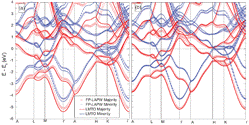Department of Physics and Astronomy: Publications and Other Research

Kirill Belashchenko Publications
Document Type
Article
Date of this Version
2015
Citation
PHYSICAL REVIEW B 91, 180408(R) (2015)
Abstract
Effects of thermal spin disorder and excessMn on the electronic spectrum of half-metallic NiMnSb are studied using first-principles calculations. Temperature-dependent spin disorder, introduced within the vector disordered local moment model, causes the valence band at the Γ point to broaden and shift upwards, crossing the Fermi level and thereby closing the half-metallic gap above room temperature. The spectroscopic signatures of excess Mn on the Ni, Sb, and empty sites (MnNi, MnSb, andMnE) are analyzed. MnNi is spectroscopically invisible. The relatively weak coupling of MnSb and MnE spins to the host strongly deviates from the Heisenberg model, and the spin of MnE is canted in the ground state. While the half-metallic gap is preserved in the collinear ground state of MnSb, thermal spin disorder of the weakly coupled MnSb spins destroys it at low temperatures. This property of MnSb may be the source of the observed low-temperature transport anomalies.


Comments
©2015 American Physical Society